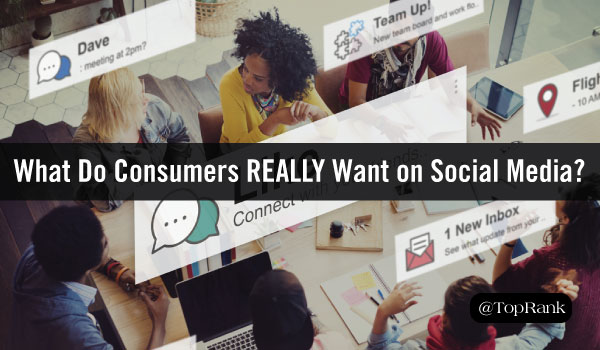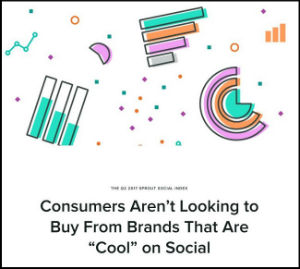
Social media marketers, do you feel a brief pang of envy when a brand gets sassy on Twitter or Facebook? Do you wish you had the brand identity and/or corporate backing to smack down a troll, a la Wendy’s?
Me too. It’s only natural. Even in a profession as inherently creative as marketing, some of us can fly our freak flags higher than others. If you’re working in financial services, or healthcare, or any number of staid verticals, odds are you have to keep your sarcasm in check.
We may never get the sweet satisfaction of seeing a tweet full of biting wit go viral. But we have to keep perspective. Are we here to get featured on Buzzfeed, or to generate revenue? Does the snark really translate to sales?
The good folks at Sprout Social just released their Q2 2017 Sprout Social Index, and they’re taking aim at precisely that question. People like brands with “personality,” sure. But what do consumers really want from brands on social media? And how should those preferences inform your social media marketing strategy? Let’s run the numbers.
#1: Funny Is Good, But It Isn’t Everything
Infusing a little humor into a brand is a good way to express personality. It lets people know that there are actual human beings behind the brand, seeking to entertain just as much as they inform.
As a once and future comedy writer, I’m an advocate for humor in marketing. But we should make sure the humor is not all that we’re bringing to the table.
Sprout Social found that while 3 in 4 consumers appreciate humor from brands, being funny was 4th on the list of what consumers really want from brands on social media:

The far-and-away winners are honest, friendly, and helpful. If you have these three covered, then you can add in the humor. On the other hand, if you’re not honest, friendly, or helpful, no level of funniness will make up for the lack.
It’s also worth noting how far down the list “trendy” and “snarky” are. There’s no shortage of brands trying to be edgy and au courant. But it looks like less than half of consumers want their brand to be the quip-slinging cool kid from a 90’s sitcom.
The bottom line: Humor is a welcome trait for a brand, but mean-spirited or edgy humor is likely to turn customers off (even if it lands you an AdWeek shoutout). And if you’re not being honest and helping people, no amount of humor can save you.
#2: Consider the Platform
Just as your brand has its own identity, every social network has a unique identity. Facebook is a casual place to post cute pictures and start political arguments. Twitter is an even more casual place to start extremely character-limited political arguments. LinkedIn is more buttoned-down and professional, with only occasional political arguments.
Your audience on each platform has a unique set of expectations, based not just on your brand, but on the platform itself.

People like personality on Facebook, YouTube and Twitter, but not so much on LinkedIn. So it’s important to adjust your messaging for each.
Most of us are scheduling social media messages with a tool like Hootsuite or Buffer, and it’s easy to blast a single message across platforms. But don’t do that. Take a few minutes to craft unique messages for each channel, keeping audience expectation in mind. That bit of extra effort will help make your posts more engaging, and keep your most dedicated audience from seeing the same message multiple times.
#3: Know Your Audience
Social media is not a homogenous audience that’s the same for every brand. It’s a platform for connecting with your particular most-valued consumers. How your brand approaches social media, then, should be a byproduct of how your audience wants to interact with your brand. These preferences can vary widely across demographics.
For example, 74% of Gen X and Baby Boomers said they found it annoying when a brand uses slang. But only 59% of Millennials shared that sentiment. Millennials are also far more tolerant of brands making fun of competing brands:

How your brand should express personality on social media is dependent on your target audience. If your demographic still uses words like “hip” and “groovy,” it’s probably not hip or groovy for your brand to use them. However, if your target audience thinks things are “totes adorbs” and “can’t even,” you stand a better chance of connecting with slang.
It’s vital to find the intersection of your brand personality with your audience preferences, and let that drive how you present the brand on social.
#4: Bring Value to Drive Sales
To quote my personal hero, Captain Obvious, “the purpose of social media marketing is ultimately to drive sales.” If going viral with a funny tweet contributes to the bottom line, that’s a tactic worth pursuing. The research shows, though, that most people aren’t following brands just for laughs:

When it comes to driving sales, humor is 5th on the list. Being responsive, offering promotions, and providing educational content are all more likely to inspire a purchase decision.
What do people really want from brands on social? The same thing they want from brands everywhere else. First, people want to be heard, to engage in a productive dialog. Second, they want to be offered something of value, whether it’s a deal on your solution or simply valuable information. When people are looking for help, you have to bring more than jokes to the table.
Check out the full Q2 2017 Sprout Social Index for more insights.
Helping People Is the Top Priority
Giving your brand a winning personality is great. It makes creating and consuming your content more fun. But personality should be the seasoning for your social media marketing, not the main course. Start with being helpful, being honest, and providing something of value in exchange for your audience’s time. Then add a little sprinkle of personality on top, like so:

See? You can be helpful and funny at the same time.
Need help maintaining your social media presence? Let us handle your social media marketing.



